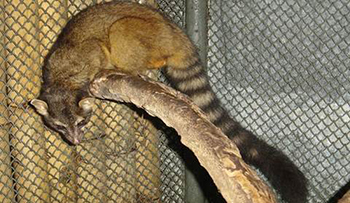The Central American Cacomistle
Bassariscus sumichrasti

Taxonomy:
Kingdom Animalia
Phylum Chordata
Class Mammalia
Order Carnivora
Family Procyonidae
Life History/Ecology:
General:
The cacomistle, B. sumichrasti, is a member of the Procyonidae family and is closely related to the North American raccoon. Cacomistles are long slender creatures. The name cacomistle is derived from the Aztec word meaning half-cat or mountain lion, depending on the storyteller. The cacomistle is about half a foot tall at the shoulders and about two and a half feet long, the tail and the body being of equal length. Cacomistle are a brownish orange with distinct ringed tail markings. Cacomistles live anywhere between 7 and 23 years. Much of what is known about the general biology of the cacomistle is derived from the research of Doctors Proglayen and Neuwall during the late 1980s.
Habitat:
The Central American Cacomistle lives in the forest and woodlands of Belize and northern Guatemala, as well as the remainder of the Yucatan peninsula and central America. The Cacomistle prefers tropical broadleaf forests, but is also found in tropical dry forests (Poglayen-Neuwall 1989). Cacomistles have non-retractable claws, but are still very good climbers. Their long slender tails provide them with added balance when making leaps between branches.
Resources:
Cacomistles are omnivores, however they prefer fruit. In one study, (Coates-Estrada and Estrada 1986), the consumption of figs by various fruit eating species, including the cacomistle were quantitatively assessed. Cacomistles have also been known to eat smaller organisms such as frogs and birds on occasion (Poglayen-Neuwall 1989). Cacomistles are subject to predation from owls and other natural predators such as jungle cats and snakes.
Reproduction:
Cacomistles are gonochoristic and reproduce sexually. The female cacomistle will be in estrus for approximately forty days, but is only fertile for one day. After a gestation period of approximately 60 days, the female cacomistle will give birth to 1-5 live young during the months of May to June (Poglayen-Neuwall 1989). Cacomistles are direct developers. The progeny will be able to forage along with its mother at two months and is weaned at three months (Poglayen-Neuwall 1989).
Behavior:
Cacomistles are solitary nocturnal animals. Cacomistles can be territorial and use calls to delineate the boundaries of their range (Poglayen-Neuwall 1989).
Economic/ Ecological Service:
Bassariscus sumichrasti is considered a nuisance animal because it has been known to prey on poultry (Poglayen-Neuwall 1989). Also Cacomistle have been hunted for their fur and meat (Nowak 1999). In the environment, Cacomistles play an important part in the dissemination of seeds in fruiting species.
Legal Protection:
The IUCN lists Bassariscus sumichrasti as near threatened and upon looking for game regulations concerning the species, none were found.
References:
Please note that the following references may have either been removed or relocated by the webpage owners since the time this student report was created.
Lundrigan, B. and T. Zachariah. 2001. "Bassariscus sumichrasti" (On-line), Animal Diversity Web. Accessed May 27, 2011 http://animaldiversity.ummz.umich.edu/site/accounts/information/Bassariscus_sumichrasti.html.
Lundrigan, B. and T. Zachariah. 2001. "Bassariscus sumichrasti" (On-line), Encyclopedia of Life. Accessed May 27, 2011 http://www.eol.org/pages/328057
Nowak, R. 1999. Walker's Mammals of the World. Vol I. Baltimore: Johns Hopkins University Press.
Poglayen-Neuwall, I. 1989. Procyonids. Pp. 450-468 in S. Parker, ed. Grzimek's Encyclopedia of Mammals. Vol 3. New York: McGraw-Hill.
Coates Estrada-Estrada, 1986. Fruiting and frugivores at a strangler fig in the tropical rain forest of Los Tuxtlas, Mexico., Journal of Tropical Ecology, Vol.2, Issue 4, Cambridge: Cambridge University Press.